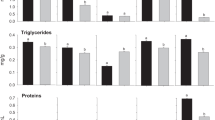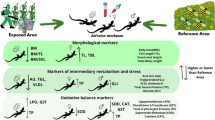Summary
Nineteen 9-week-old brown pelicans (Pelecanus occidentalism), obtained from a colony in Vero Beach, Florida, containing environmentally acquired p,p′-DDE residues, were subjected to a food deprivation experiment. Samples of brain, liver, muscle, and fat taken after one and two week periods of starvation indicated that starved birds contained significantly greater residue levels in fat compared to non-starved controls. Such differences were not observed in residues in the other tissues. The significance of these findings is discussed in relation to the biology of brown pelicans.
Similar content being viewed by others
Literature cited
BERNARD, R. T.: Publ. Museum, Mich. State Univ. 2:155–192 (1963).
DALE, W. E., T. B. GAINES and W. J. HAYES, JR.: Toxicol. Appl. Pharmacol. 4:89–106 (1962).
ECOBICHON, D. J. and P. W. SASCHENBRECKER: Toxicol. Appl. Pharmacol. 15:420–432 (1969).
FINDLAY, G. M. and A. S. W. DEFREITAS: Nature 229: 63–65 (1971).
HARVEY, J. W.: Can. J. Zool. 45:629–633 (1967).
SCHMIDT, R. and W. DEDEK: Experientia 28:56–57 (1972).
SCHREIBER, R. W.: Unpublished data (1975).
SCOTT, J. J., J. A. WIENS and R. R. CLAEYS: J. Wildl. Manage. 39:310–320 (1975).
SODERGREN, A. and S. ULFSTRAND: Ambio 1:36–40 (1972).
STICKEL, L. and W. STICKEL: Ind. Med. Surg. 38:44–53 (1969).
THOMPSON, N. P.: Unpublished data (1975).
THOMPSON, N. P. and R. L. EMERMAN: Bull. Environ. Contam. Toxicol. 11:474–482 (1974).
Author information
Authors and Affiliations
Additional information
Florida Agricultural Experiment Station Journal Series No. 6081.
Rights and permissions
About this article
Cite this article
Thompson, N.P., Courtney, C.H., Forrester, D.J. et al. Starvation-pesticide interactions in Juvenile Brown pelicans. Bull. Environ. Contam. Toxicol. 17, 485–490 (1977). https://doi.org/10.1007/BF01685942
Published:
Issue Date:
DOI: https://doi.org/10.1007/BF01685942




